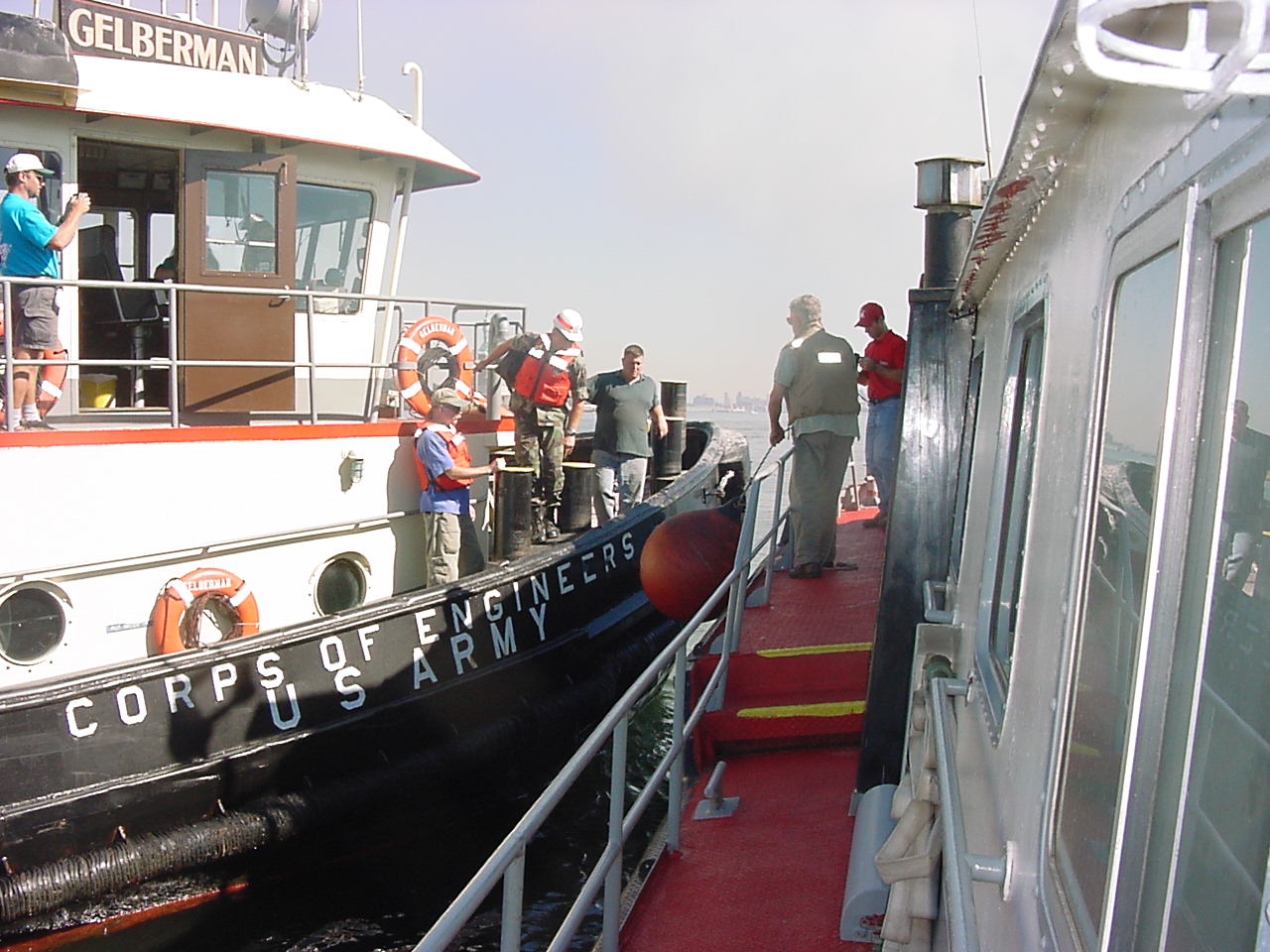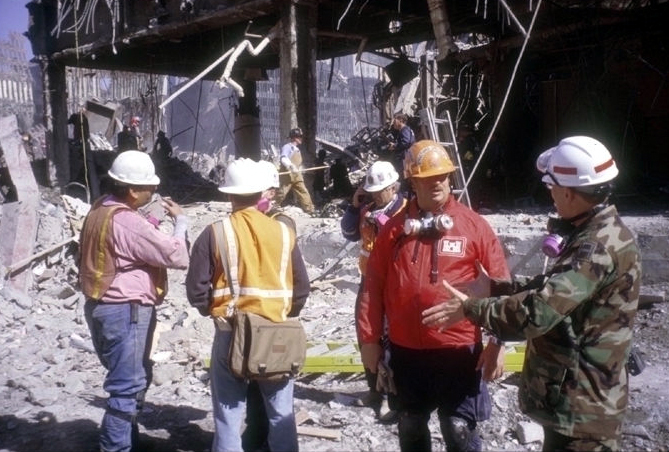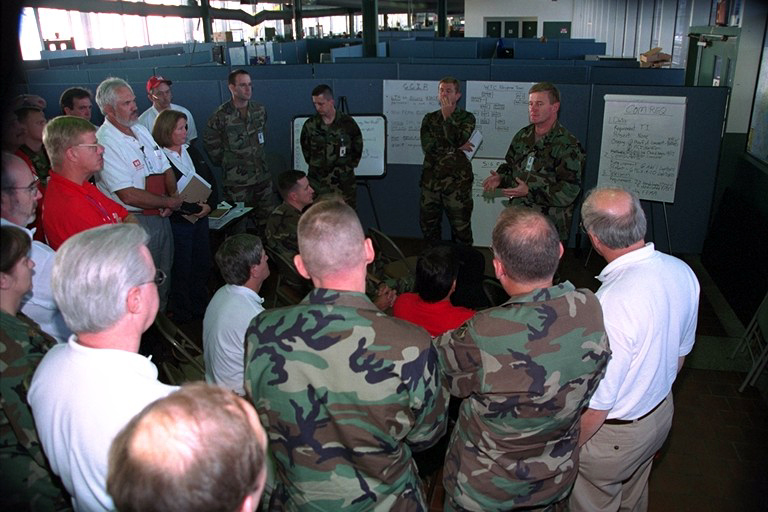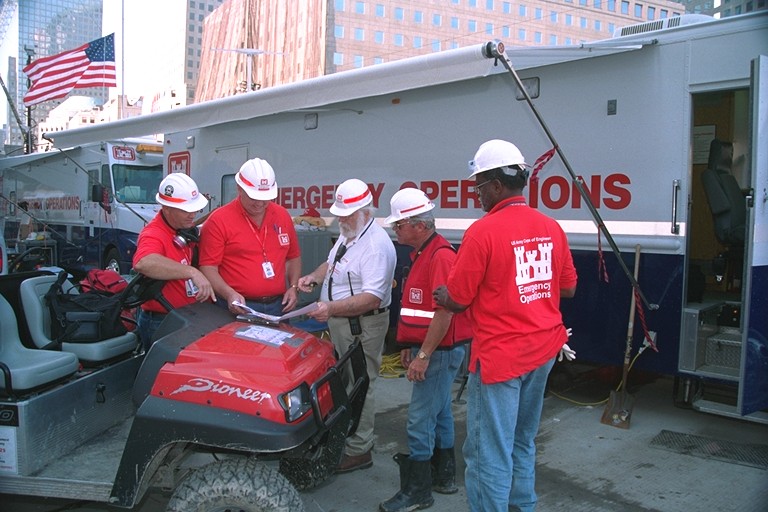IV. The Corps Mobilizes to New York
| |
 |
| |
From the first moments following the attacks in New York, USACE floating plant were crucial to the rescue and recovery effort, transporting people and supplies to and from Manhattan. The tugboat Gelberman was one of the vessels participating in the effort.
Office of History. |
In April 1998, several years before the 9/11 attacks, the U.S. Army Corps of Engineers (USACE) launched Readiness 2000 (R2K) which fundamentally changed the way it managed and organized its emergency response mission. R2K incorporated threat-based funding, a deployable tactical operations system, an all-hazard training center, and a national database. It also embraced the concept of Planning and Response Teams to execute pre-assigned mission sets. These were locally established teams the Corps could deploy nationwide, allowing the Corps to leverage local expertise nationally. This framework allows USACE to draw on the skills of the entire organization and to relieve the stress on the district in which the disaster has taken place. This structure was further enhanced by the use of new technology that allowed USACE employees on the ground to reach back to experts virtually anywhere for assistance. The value of this disaster response procedure was proven on September 11, 2001, when terrorists crashed hijacked airliners into the World Trade Center in New York, the Pentagon, and rural Pennsylvania.
The USACE New York District offices were just blocks from the World Trade Center and were damaged in the attack. Forced to evacuate, the district’s highest priority was the safety and accountability of its staff and their families. In the wake of the unfolding disaster, with no offices, lacking communication and transportation, and experiencing extreme stress, the New York District was effectively incapacitated. No USACE district ever wants to be designated a victim district, but it was clear that the New York District could not manage the USACE response and needed assistance from the New England District in Boston and the North Atlantic Division in Brooklyn.
On September 12, an 11-person team from the New England District traveled to New York to assess the situation on the ground while staff in the office established contact with the Federal Emergency Management Agency (FEMA) in accordance with what is now known as the National Response Framework. Soon after, the commander of the North Atlantic Division designated the New England District commander as the New York District Commander–Forward, responsible for managing the USACE response. The New York District commander would work to rally his district staff, reconstitute the office, and complete the work necessary to close out the government fiscal year, which would end on September 30.
USACE began to stand up its response to the attack. First, although the planned deployment of experts from throughout the Corps was complicated by the nationwide shutdown of air and train travel through September 13, specialists traveled by car until then. Second, the New England District and the North Atlantic Division coordinated with New York City, the State of New York, the Federal Emergency Management Agency, other governmental agencies, and USACE Headquarters. Third, Corps staff created a USACE Emergency Response Office and command structure. Because USACE works under FEMA during disasters, an administrative structure must be in place to carry out assigned missions while ensuring accountability of federal disaster funds.
 |
 |
|
USACE engineers at the debris site in lower Manhattan days after the attack.
Office of History.
|
Lt. Gen. Robert B. Flowers, the 50th Chief of Engineers,
speaks with USACE soldiers and civilians working in New York. Office of History. |
 |
|
USACE provided several mobile command posts to support its recovery efforts,
which were vital for communications while the local networks were disabled. Office of History.
|
The initial missions FEMA assigned to USACE were search and rescue and structural engineer building assessment and stabilization support at the World Trade Center site, the latter to ensure that those doing the rescue and recovery work were not endangered. Supplying adequate power was vital to the work. In the Readiness 2000 program, the Corps of Engineers assigned the 249th Engineer Battalion (Prime Power) to aid Corps divisions and districts in restoring power and providing temporary power after disasters. The 249th had a long history of combat engineering since World War II and had, since 1994, permanently supported the Prime Power program, providing aid to Army units with power planning and development. Within days of the attacks, thirty-one personnel from the 249th had deployed to the city and a 249th-Con Ed team installed two generators to power the financial district—including the New York Stock Exchange—until Con Ed could get power back online. The mission was complete by 20 September. “This is typical of what our unit has done at all disaster sites,” 249th Battalion Commander Lt. Col. Kevin Wilson said.
Another element of USACE support to the rescue and recovery effort was logistics, a mission the Philadelphia District undertook from several locations. Those working in New York, from USACE as well other agencies, needed housing, food, and transportation . Necessary safety equipment and supplies also needed to be delivered to Lower Manhattan. The Philadelphia District also served as the logistics hub for personnel arriving to work in Manhattan, and it provided personnel accountability and issued equipment. It soon became apparent that extra public affairs staff would be needed to handle the large number of media inquiries, to ensure that public information was complete and accurate, and to handle visits of elected officials and senior U.S. Government leaders to Lower Manhattan. Public affairs specialists from multiple USACE districts came to New York to help. USACE financial specialists also deployed to guarantee that federal disaster relief funds were spent legally and that there was no fraud or waste. Contract specialists arrived on site and continued to issue contracts in accordance with Army and USACE standards despite the urgency of the situation. Finally, veteran senior leaders volunteered to come to New York, both to manage the geographically diverse USACE workforce and the multiple missions as well as to cultivate and maintain working partnerships with the local, state, and federal officials involved in the recovery effort.
The events of September 11 were unprecedented in that the disaster was a terrorist attack rather than a natural disaster. Communications and transportation were significantly affected. The local USACE district was profoundly impacted as never before during a USACE disaster response mission. Nevertheless, the Corps was able to move people and resources to the disaster site within hours and implement its response plan smoothly despite the daunting circumstances. Ultimately the entire organization contributed to the effort, in one way or another, to help the people of New York City recover and eventually rebuild.
September 2021. No. 147.
Office of History's series of articles remembering the responses to the attacks of September 11, 2001